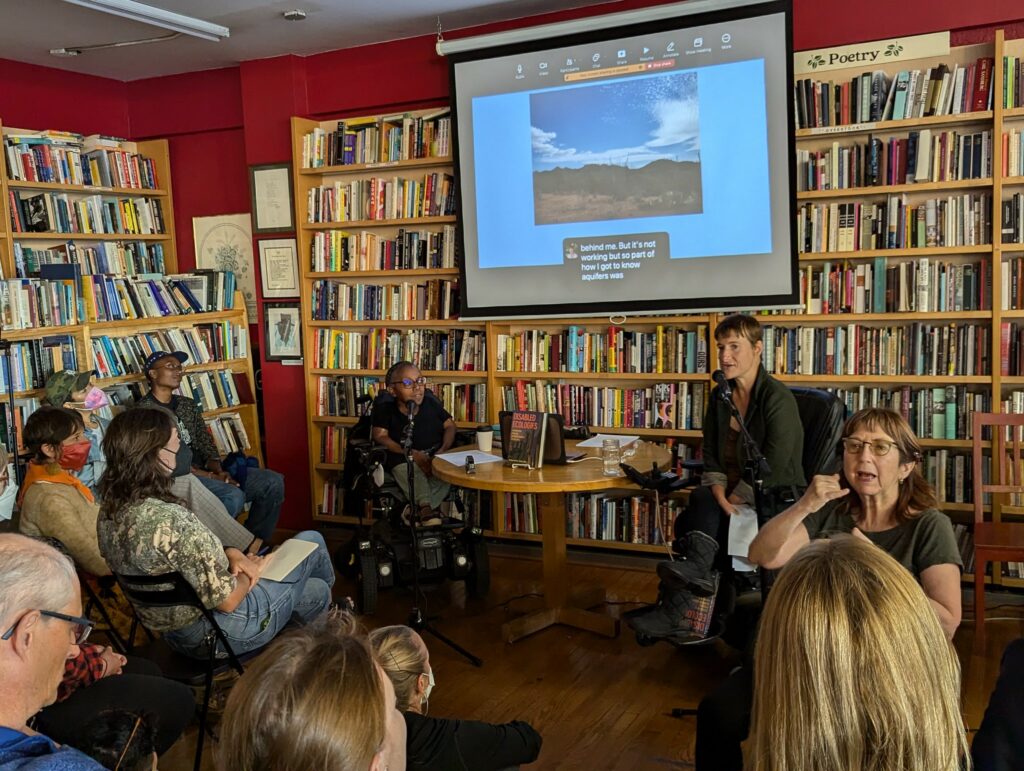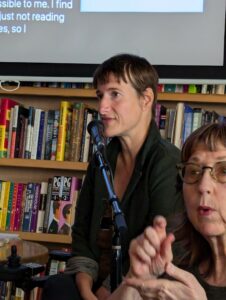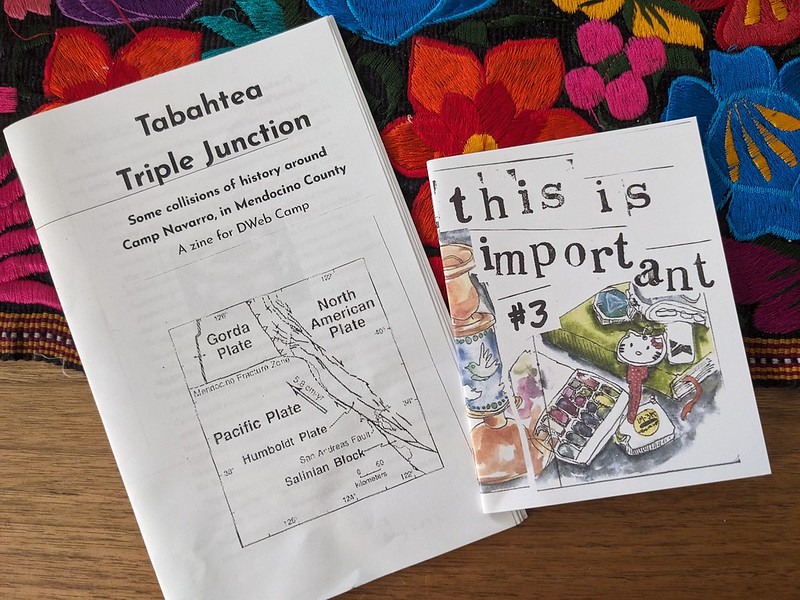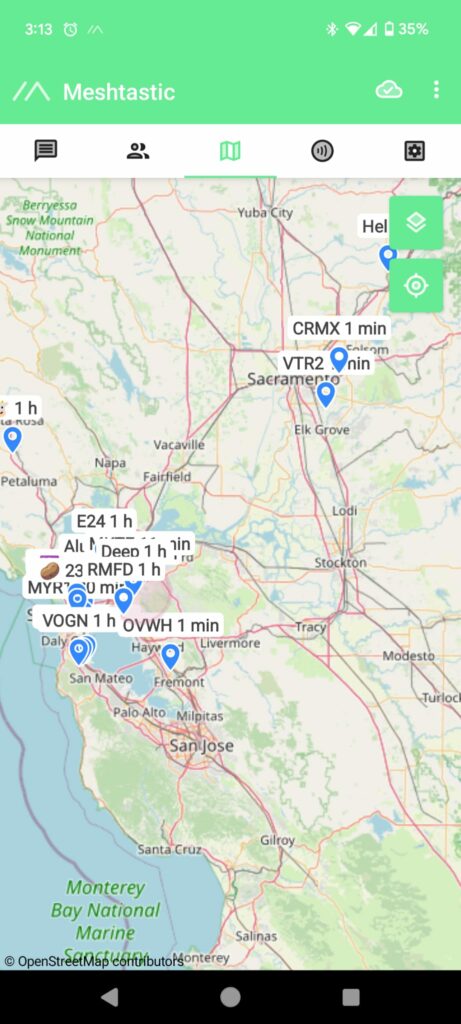Experimental liveblogging! I’m in Berkeley at Pegasus Books for Sunaura Taylor‘s book event for Disabled Ecologies. Sunaura is here in conversation with Yomi Young from the Shelterwood Collective.
I have been reading the book on Kindle but like it so well that I want a physical copy too!

You can read more about Yomi and her activist work in a zillion places but check out StoryCorps and maybe this article on the DJCC’s work early in the pandemic.
As Sunaura started her talk it only just now hit me that Sun-aura = Sonora like the Sonoran Desert. Oh! How did I miss that.

Crowd instantly on board with Yomi’s joke about doing some comedy performance art where they try to pass each other sheaf of papers in crip time (miming dropping papers and scrambling with hands)

Sunaura reads us a short section from the introduction, Age of Disability. “Environmenal destruction is a story of disablement.” (Of people and of the land). “Mass ecological disablement of the human and non-human world.” Her story and her research are deeply rooted in Tucson’s history.
I lived in Tucson briefly – only for a few months, but I loved it and the desert and its life very much! Good memories of my many visits (with membership) to the Desert Museum, geologizing all over with Halka Chronic’s classic Roadside Geology of Arizona, and sneaking through the weird ruins of Biosphere 2!
A main point of the book is that just as disabled people have adapted and created ways of being, living, healing, doing care work, and finding joy, we can, or must, do the same with our relationship with the land.
Yomi mentions being blown away by the balance of philosophical discussion and personal history in the book. She asks Sunaura, Why now? Sunaura replies, she knew she would write it someday and her whole career has been leading up to it. And it has taken her 9 years to write! Her own life is entangled with the narrative of pollution on the southwest side of Tucson near the air force base and Hughes facilities. Her origin story gives her the roots of thinking about disability and nature. Not just her individual problem but that it is a political issue caused by systems of harm, racism, war, etc. and impact a whole community. Injury to nature is harm to all of us humans.
(It is like 1 million degrees in this bookstore as we are a large crowd sitting on a raised platform (there was a lift). My kingdom for a fan, or the space to leave and find a bathroom to remove the long underwear I unwisely wore so I would not be cold on the way home. I also regret the woolly socks. )
Yomi talks about the way the book is constructed. She loves how obsessed with aquifers Sunaura is. The book itself has an aquifer! Which has this nuanced way of organizing information. The pages of the book have , running along the book, an aquifer with extra explanations!
Aw I love this. Yomi has the soul of a poet. And one that admires huge nerdiness. Yay!
Sunaura says this is her favorite question because she loves aquifers so much! She talks about understanding aquifers as relational and as connected. “Magical holders of ancient time.” Unimaginable amounts of water under there, fossilized water.
She notes that because she doesn’t use her hands to read, she doesn’t like footnotes at the end of the book. So the running footnotes felt better to her and metaphorically became parallel in her mind to the underground running stream of information underlying the book.
Yomi says the book is an important one for disabiliyt studies but also for the environmental movement as it is not often Yomi sees environmentalist advocacy or research that includes disability – She feels it is a gift to our community. Sunaura has blown her mind with the new framing of community, disabled ecology.
Sunaura takes that idea and talks about disabled ecologies and communities. When she returned to Tucson as an adult she was following the trails of disability. The pollution and contamination left a trail of people, of wildlife, who were harmed. Wildlife was drinking from the unlined, uncovered pits. The trees died. And the aquifer was permanently altered. Material injuries didn’t just impact humans. Disabled Ecologies is in some ways a mapping project. (You can map not just where the weapons are made, but where they go off.) Disability not just a personal lived experience. She talked with many people and there were so many narratives of disability and illness, in public health, in community activists, in litigation, and these narratives – and mobilizations were often racialized in various ways.
Another short reading – from the chapter The Ground Beneath My Wheels. “What was I to make of this patch of land…” She felt a sense of solidarity with the injured landscape and was drawn to get to know it just as she was drawn to get to know the human communities. “How was I to write myself back into nature?” She then reads a quote that mentions Yomi and her work! (Audience goes oooooh!) Sunaura then reads a bit that mocks the hell out of Edward Abbey and his misogynist, ableist, colonialist writing. (Quotes about possessing a beautiful woman; and a bit where Abbey exhorts everyone to get up out of their motorized wheelchairs. (Audience laughs and boos; I have double flipped off the air for good measure. Cartoonishly bad!)
Knowing an aquifer wasn’t hindered by (in)accessiblity – it needs research, imagination, and understanding to become intimate with the aquifer. “The injured underground became a sort of companion.” “The desert I desired was bursting with community.” “Knowing the desert was not nearly as important as learning to be responsible to it.”
Yomi talks about her own work about land and disabled embodiement. That disability is incompatible with nature – this is a lie – And that natural spaces must be pristine and untouched – that we (disabled people especially but all humans) damage and corrode it. We who have been harmed should be leading the thinking about how to heal together with the land.
Yomi asks Sunaura about Mexican American communities who fought so hard for the environmental damage to be recognized. They continued naming it over and over and confronting environmental racism in a way that was so effective. Outside of movements, we don’t often hear these stories, it’s all Erin Brokovich where someone comes in to save the people. The skill this community had to use every possible tool at their disposal – including impact litigation – is great.
Sunaura – Talks about Yomi’s work with Shelterwood. She started off this project not knowing about the decades of incredibly environmental justice activism in South Tucscon. They should be given credit for the aquifer protection laws that were passed in Arizona. They were really badass but even in Tucson they are not well honored. Decades of contaminated groundwater. the city officials did nothing. No investigation, etc. But the community knew something was wrong. And then in the 1980s as they mobilized the City blamed it on their “lifestyle” or their diet, racist ableist ways to deny responsibility and making the community feel it was their own fault. This is often something that happens with disability!
Then at some point people were like, cleaning up the environment is one thing but right now we all need health care!
Time check! It is nearly 7, yay read the book! Any questions!
Audience m ember asks What happened then! (We all holler, you have to read the book!) Sunaura and Yomi: The story continues. For a while, they got a health program at a clinic. They won a historic groundwater protection fight and passed strong legislation. But the continued fuckery of the system is still harming people. And they are fighting for things they need to live and thrive as disabled people. There is no end.
Yomi: It never ends. And it’s very important that we don’t leave anyone behind. We don’t stamp out disability. It’s part of the human condition. It’s about, how do we live with disablement. Not leaving bodyminds behind, moving together, at the pace of our most marginalist and most disabled. That’s what is really beautiful about it.
Sunaura: it is a hopeful book and the framing of disability is a hopeful one. i know from the beautiful expansive world of disablity community . how can we make that reality one for the non human world as well?
A really lovely interview and talk, and I look forward to actually finishing the book!
So far, it makes me think about what I was trying to say in my short essay here, “Thoughts on AI, comradeship, ethics, interdependence” which I rewrote and made a bit longer for my zine Tabahtea Triple Junction. There, I started in a different place, with some recent discourse on AI and sentience, and tried to recontextualize it to the relationships we build with non human things including land. Sunaura’s book is crystalizing a lot of that thinking for me in a very useful way!
Coincidentally I also just re-read some of the Haraway she mentions and my friend unixjazz had messaged me a few days ago to say he found an OG copy of Sandra Harding‘s The Science Question in Feminism from 1986 while he was on vacation and snagged it for me (another book mentioned in Disabled Ecologies!) So maybe it is no wonder we are thinking about similar issues as we imagine the underground ebbs and flows! I will be going to unixjazz’s Common Tools event later this month to talk about DIY assistive tech as a liberatory idea with ecological connections, too!







